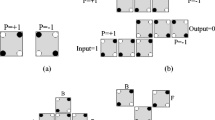Abstract
Energy efficiency is an important issue to consider when it comes to digital systems development. Despite all the accomplishments in CMOS evolution, there has been an active search for its replacement. Although most of these emerging technologies present very low power consumption, they are energetically bounded by a hard thermodynamic limit. In an attempt to help design systems capable of going beyond the limit aforementioned, we focus on embedding a new clocking scheme in the main CAD tool for quantum-dot cellular automata. More specifically, we implemented the Bennett clocking scheme and a partially reversible pipeline in the QCADesigner software simulator. We also carried out an energy-throughput analysis for the state-of-the-art benchmark combinational suite. Our results, compared to the conventional clock, show that in 60% of the circuits, the energy improvement surpasses the throughput degradation for the best energy configuration. When throughput is a concern, the designer has on average 15 different configurations for each of these benchmark circuits that can be traded trade between these metrics. To the best of our knowledge, this work presents the first attempt to add reversible features in the main CAD tool for QCA systems design and show an analysis of viable clock configurations for the circuits mentioned above. These efforts open new perspectives in designing QCA systems where energy efficiency is mandatory.









Similar content being viewed by others
References
Amarù, L., Gaillardon, P.E., De Micheli, G.: The EPFL combinational benchmark suite. In: Proceedings of the 24th International Workshop on Logic & Synthesis (IWLS) (2015)
Anderson, N.G.: Gate abstractions and reversibility: on the logical–physical link. In: 2013 IEEE 56th International Midwest Symposium on Circuits and Systems (MWSCAS), pp. 1059–1062. IEEE (2013)
Bennett, C.H.: Logical reversibility of computation. IBM J. Res. Dev. 17(6), 525–532 (1973)
Bérut, A., Arakelyan, A., Petrosyan, A., Ciliberto, S., Dillenschneider, R., Lutz, E.: Experimental verification of Landauer’s principle linking information and thermodynamics. Nature 483(7388), 187–189 (2012)
Cavin, R.K., Lugli, P., Zhirnov, V.V.: Science and engineering beyond Moore’s law. Proc. IEEE 100(13), 1720–1749 (2012)
DeBenedictis, E.P.: The Boolean logic tax. Computer 49(4), 79–82 (2016)
Ercan, I., Anderson, N.G.: Heat dissipation in nanocomputing: lower bounds from physical information theory. IEEE Trans. Nanotechnol. 12(6), 1047–1060 (2013)
Hong, J., Lambson, B., Dhuey, S., Bokor, J.: Experimental test of Landauer’s principle in single-bit operations on nanomagnetic memory bits. Sci. Adv. 2(3), e1501492 (2016)
Lambson, B., Carlton, D., Bokor, J.: Exploring the thermodynamic limits of computation in integrated systems: magnetic memory, nanomagnetic logic, and the Landauer limit. Phys. Rev. Lett. 107(1), 010604 (2011)
Landauer, R.: Irreversibility and heat generation in the computing process. IBM J. Res. Dev. 5(3), 183–191 (1961)
Lent, C.S., Liu, M., Lu, Y.: Bennett clocking of quantum-dot cellular automata and the limits to binary logic scaling. Nanotechnology 17(16), 4240 (2006)
Lent, C.S., Tougaw, P.D.: A device architecture for computing with quantum dots. Proc. IEEE 85(4), 541–557 (1997)
Li, M., Vitanyi, P.: Reversibility and adiabatic computation: trading time and space for energy. In: Proceedings of the Royal Society of London A: Mathematical, Physical and Engineering Sciences, vol. 452, pp. 769–789. The Royal Society (1996)
Martini, L., Pancaldi, M., Madami, M., Vavassori, P., Gubbiotti, G., Tacchi, S., Hartmann, F., Emmerling, M., Höfling, S., Worschech, L., et al.: Experimental and theoretical analysis of Landauer erasure in nano-magnetic switches of different sizes. Nano Energy 19, 108–116 (2016)
Naghibzadeh, A., Houshmand, M.: Design and simulation of a reversible ALU by using QCA cells with the aim of improving evaluation parameters. J. Comput. Electron. 16(3), 883–895 (2017)
Nikonov, D.E., Young, I.A.: Overview of beyond-CMOS devices and a uniform methodology for their benchmarking. Proc. IEEE 101(12), 2498–2533 (2013)
Ottavi, M., Pontarelli, S., DeBenedictis, E.P., Salsano, A., Frost-Murphy, S., Kogge, P.M., Lombardi, F.: Partially reversible pipelined QCA circuits: combining low power with high throughput. IEEE Trans. Nanotechnol. 10(6), 1383–1393 (2011)
Sen, B., Dutta, M., Goswami, M., Sikdar, B.K.: Modular design of testable reversible ALU by QCA multiplexer with increase in programmability. Microelectron. J. 45(11), 1522–1532 (2014)
Srivastava, S., Asthana, A., Bhanja, S., Sarkar, S.: Qcapro-an error-power estimation tool for QCA circuit design. In: 2011 IEEE International Symposium on Circuits and Systems (ISCAS), pp. 2377–2380. IEEE (2011)
Thapliyal, H., Ranganathan, N.: Reversible logic-based concurrently testable latches for molecular QCA. IEEE Trans. Nanotechnol. 9(1), 62–69 (2010)
Walus, K., Dysart, T.J., Jullien, G.A., Budiman, R.A.: Qcadesigner: a rapid design and simulation tool for quantum-dot cellular automata. IEEE Trans. Nanotechnol. 3(1), 26–31 (2004)
Acknowledgements
The authors would like to thank CAPES, CNPq, and Fapemig for supporting this work.
Author information
Authors and Affiliations
Corresponding author
Rights and permissions
About this article
Cite this article
Chaves, J.F., Ribeiro, M.A., Silva, L.M. et al. Energy efficient QCA circuits design: simulating and analyzing partially reversible pipelines. J Comput Electron 17, 479–489 (2018). https://doi.org/10.1007/s10825-017-1120-6
Published:
Issue Date:
DOI: https://doi.org/10.1007/s10825-017-1120-6




